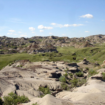Hat’s history of honouring Indigenous ‘abysmal’
By Letter to the Editor on October 9, 2018.
Parks should be commended for trying to protect the Saamis site. Admittedly it should have been done years ago, but once they saw the damage they recognized their legal obligation to protect this Designated Historic Resource, of archaeological significance within the North American Plains. The City of Medicine Hat bills itself as a “community of choice” and that is very true. It is an excellent place to live; its very name admits place familiarity long before the coming of the railway It makes sense. Here, three creeks that drain vast areas meet, providing gentle access to a river that is generally framed on one side or the other with steep cliffs. The 1883 railroad surveyors very likely followed an ancient trail as they laid out the path of the railway. They weren’t surprised to see tepees. Would they, however, have been surprised to realize that the land under their feet held evidence of 9,500 years of use by early peoples? In the ensuing years many locals collected artifacts. They later spoke in wonder of the sites that “used to be” here. Their collections are proof of history but without a relationship, a context, the cultural story is lost. In 1973 the Alberta Historical Resources Act was passed so that information could be collected before sites were destroyed. In 1984 the Saamis Site was recognized for its historical significance and for the quality and quantity of artifacts. Archaeological investigation showed multiple occupations over hundreds of years, a time before the horse and before European contact. It was a location of peace and industry; food was prepared, hides worked for clothing or shelter, pottery used, shells beads made. Our city’s name uses its name Medicine Hat and the Saamis Tepee as iconic reminders that it is set apart in the remembrance of early peoples. Justly so, this is for us, as it was for them, a good place to live. But our commitment to honouring Indigenous history is abysmal. A burial ground by Sholten Hill Road was blatantly looted and bulldozed. The South Ridge subdivision took an impressive 4,500 year old Oxbow site. The Ross Glen subdivision by the creek obliterated several sites ranging from 1,500 to 5,000 years before present. But we have one site, of scientific significance that was guaranteed protection, (penalties of up to a 50,000 fine or jail), by both the Historical Resources Act and the City. That is the Saamis Site. Adjacent hunting and camp sites connected to Saamis have been damaged by careless watershed planning. Some parts of the Saamis site are exposed to daily erosion because the protective grass layer has been destroyed. At present it still holds so much potential as a valuable record of the daily activities of peoples here long before us. Let us act quickly to protect it. Janice Andreas Medicine Hat 9-8





